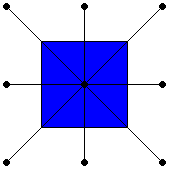7 The Brillouin Condition
From the Laue condition, a different condition for diffraction can be derived. It is again equivalent to both Laue and Bragg.
k' - k = G and so k' = G + k
Taking the dot product of both sides,
(k' · k') = (G + k) · (G + k)
Hence k' · k' = G · G + 2G · k + k · k
But the magnitudes of k and k' are equal so k' · k' and k · k cancel.
Hence 2G · k = -G · G
If there is a reciprocal lattice point at the position G there is also one at -G so the minus sign is unnecessary.
Hence k · ½G = ½½G ½2 (7)



